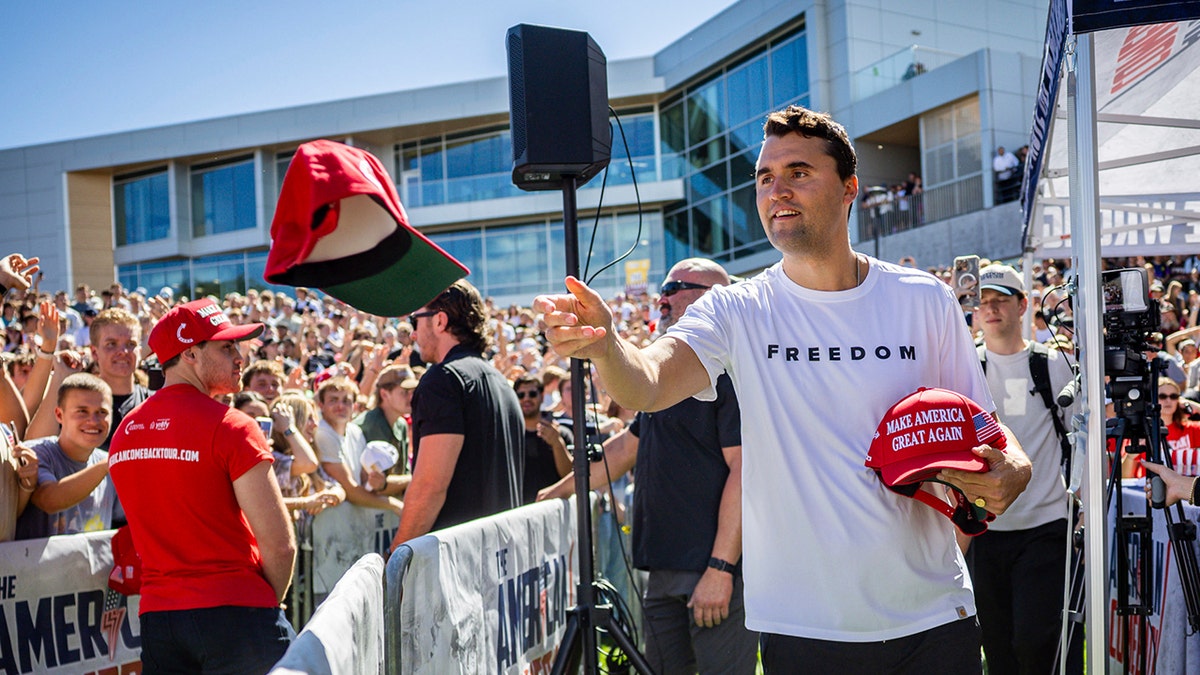On October 9, 2025, Turning Point USA (TPUSA), a conservative nonprofit organization founded by the late Charlie Kirk, announced plans to host an alternative Super Bowl halftime show, dubbed the “All-American Halftime Show,” scheduled for February 8, 2026, during Super Bowl LX at Levi’s Stadium in Santa Clara, California. This initiative aims to counter the NFL’s selection of Puerto Rican artist Bad Bunny as the official halftime performer.
The NFL’s announcement of Bad Bunny as the Super Bowl LX halftime headliner marked a historic moment, as he became the first primarily Spanish-language artist to headline the event as a solo act.
Born Benito Antonio Martínez Ocasio, Bad Bunny is a Puerto Rican reggaeton and Latin trap artist who has been vocal about his political views, particularly concerning U.S.
immigration policies and his criticism of former President Donald Trump. His outspoken stance has garnered both admiration and controversy, especially among conservative circles.

In response to Bad Bunny’s selection, TPUSA announced its intention to create a competing halftime show that would celebrate what it describes as “faith, family, and freedom.”
The organization emphasized that the event would feature music performed in English, a direct contrast to Bad Bunny’s predominantly Spanish-language performances.
The initiative has sparked a cultural debate, with supporters viewing it as a patriotic alternative and critics perceiving it as divisive and exclusionary.
The “All-American Halftime Show” is set to livestream during Bad Bunny’s official halftime performance. TPUSA has indicated that the event will showcase a variety of musical genres, including Americana, classic rock, country, hip-hop, pop, worship, and “Anything in English.”
The organization has also conducted a survey to gather public input on preferred music genres for the show. While specific performers have not been announced, discussions have reportedly involved the rock band Creed, and conservative influencer Jack Posobiec is said to have played a role in initiating the idea.
The event is being promoted through TPUSA’s social media platforms, with a website providing updates and collecting fan input. The organization has stated that more information and musical artists will be announced at a later date
The announcement of the “All-American Halftime Show” has elicited a range of responses. Supporters of TPUSA view the event as a necessary counterbalance to what they perceive as the NFL’s embrace of “woke” culture, particularly in its selection of a Latin artist for the halftime show They argue that the event will restore traditional American values to the Super Bowl experience. Critics, however, argue that the initiative reflects a broader cultural and political divide in the United States.
They contend that the emphasis on English-language performances and the framing of the event as “100% American, 0% Apology” may alienate non-English-speaking communities and perpetuate a narrative of exclusion. Some have also pointed out the irony in organizing a cultural event that contrasts with the multilingual and multicultural fabric of American society.
The controversy has also drawn attention to the role of the Super Bowl halftime show as a platform for cultural expression. Over the years, the event has featured a diverse array of artists from various backgrounds, reflecting the multicultural nature of the United States. The selection of Bad Bunny, a Latin artist, is seen by many as a celebration of this diversity.
In contrast, TPUSA’s proposed show appears to emphasize a more homogeneous cultural identity. This juxtaposition underscores the ongoing cultural debates surrounding national identity, representation, and inclusivity.
As the date of Super Bowl LX approaches, the debate over the “All-American Halftime Show” is likely to intensify. The event has become a focal point in the broader conversation about cultural representation and the intersection of politics and entertainment.
Whether TPUSA’s alternative show will attract a significant audience remains to be seen, but its very existence highlights the deepening cultural divides within American society. For now, the stage is set for a cultural showdown that will unfold during one of the most-watched television events of the year.
Turning Point USA’s decision to launch the “All-American Halftime Show” is more than a simple protest; it represents a calculated strategy to capture cultural influence among a younger, politically engaged demographic.

TPUSA has historically focused on college campuses and social media campaigns to advance conservative viewpoints, often leveraging polarizing issues to galvanize support.
By positioning its event as an alternative to the mainstream NFL halftime show, the organization seeks to create a symbolic space where its ideology is the centerpiece rather than a peripheral commentary.
The timing of the livestream is strategic: By directly coinciding with Bad Bunny’s performance, TPUSA ensures maximum exposure. Viewers who tune into the Super Bowl for halftime entertainment are presented with an alternative narrative that emphasizes traditional American values.
The messaging—“100% American, 0% Apology”—is deliberately provocative, aimed at signaling ideological clarity and defiance against what TPUSA perceives as cultural overreach by mainstream entertainment platforms.
In interviews, spokespeople for TPUSA have articulated that the show is designed to celebrate “faith, family, and freedom,” core principles the organization argues have been underrepresented in contemporary pop culture.
This framing appeals to conservative audiences who feel marginalized by mainstream media’s embrace of globalized, multicultural, and often progressive narratives in music and entertainment.
The All-American Halftime Show promises a blend of music genres that TPUSA believes reflect a traditional American sound. The organization has opened public voting on three primary categories: “Anything in English,” “Americana,” and “Worship.” Each of these selections carries symbolic weight:

-
Anything in English – Emphasizing English-language performances serves as a cultural statement about the primacy of American traditions and linguistic identity. TPUSA supporters argue that a predominantly Spanish-language performance, while celebrated by many, does not reflect the mainstream American experience.
-
Americana – This genre includes folk, country, and classic rock, evoking imagery of small-town America, patriotism, and historical continuity. By centering Americana, TPUSA aligns the event with nostalgic values and an idealized version of the nation’s cultural heritage.
-
Worship – Integrating religious music reinforces the role of faith in public life, a cornerstone of TPUSA’s ideological messaging. It positions the event as morally grounded, appealing to audiences for whom religiosity is inseparable from national identity.
The mix of genres also suggests an attempt to reach diverse audiences within the conservative spectrum, from devoutly religious individuals to secular patriots. Though critics view these programming choices as exclusionary, supporters argue that they provide an underrepresented alternative in an entertainment landscape increasingly driven by global trends and progressive social values.
The announcement of the All-American Halftime Show ignited an immediate and polarized response. Conservative outlets and commentators praised the initiative as a long-overdue intervention in cultural programming.
Conversely, mainstream media and liberal commentators criticized the event for its divisive undertones. They argue that framing the show as “100% American” implicitly excludes multicultural communities, including the millions of Spanish-speaking Americans who celebrate Latin music. Critics warn that the initiative may further polarize audiences and transform a largely apolitical entertainment event into a cultural battleground.
Analysts note that this clash is emblematic of a broader trend in American media, where entertainment is increasingly intertwined with political identity. Just as streaming platforms have become arenas for ideological debates, the Super Bowl—once a unifying national spectacle—has now become a site for cultural contestation. TPUSA’s alternative show exemplifies how organizations can leverage entertainment events for ideological mobilization.
The potential impact of TPUSA’s All-American Halftime Show is multifaceted. From a cultural perspective, it challenges the assumption that mainstream entertainment platforms hold a monopoly over national narratives. By providing a real-time alternative, TPUSA creates a parallel cultural universe where conservative values are celebrated without compromise.
However, the strategy carries risks. Critics argue that the overtly oppositional framing could alienate moderate viewers who might perceive the event as needlessly confrontational.
Additionally, by centering language and religious identity, TPUSA may inadvertently reinforce the perception that its brand of “American” culture is narrowly defined, further fueling debates about inclusion and representation.
The All-American Halftime Show raises deeper questions about national identity and cultural representation. Historically, the Super Bowl halftime show has showcased artists who reflect the evolving diversity of the United States. From Beyoncé and Shakira to Paul McCartney and U2, performances have spanned genres, languages, and national origins.
Bad Bunny’s selection is a continuation of this tradition, highlighting the influence of Latin music and the growing Hispanic population in the U.S. TPUSA’s response, in contrast, reflects a cultural tension: an effort to assert a singular vision of what it means to be American in the 21st century.
This tension mirrors broader societal debates over language, immigration, multiculturalism, and patriotism. In essence, the cultural showdown between Bad Bunny and TPUSA is more than entertainment—it is a microcosm of competing visions for the nation’s identity.
TPUSA’s reliance on livestreaming reflects an understanding of contemporary media consumption habits. Unlike traditional broadcast networks, livestreaming allows for direct interaction with viewers, real-time polling, and immediate feedback.
Supporters can vote on music genres, submit questions to performers, and share the event across social media platforms. This interactive component distinguishes the All-American Halftime Show from conventional performances, positioning it as a participatory experience rather than a passive spectacle.
The use of digital platforms also enables TPUSA to bypass traditional media gatekeepers. In doing so, the organization can craft a message free from editorial constraints, appealing directly to its target demographic. This approach underscores the role of technology in shaping contemporary cultural and political discourse.
The All-American Halftime Show may set a precedent for future cultural counterprogramming initiatives. If successful, other organizations could adopt similar strategies to challenge mainstream events, creating parallel entertainment ecosystems aligned with specific ideological agendas.



Leave a Reply